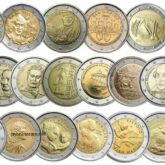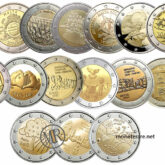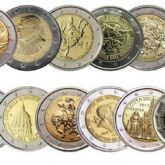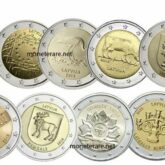Gold coins have always been the most valuable coins that man has ever made. The rare metal allowed the coin to be recognized over the millennia thanks to the maintenance of its exchange value and therefore served as an excellent currency.
Introduction
Throughout history, many gold coins have been minted since the time of the first gold (and silver) coin invented in the seventh century BC in Lydia, Asia Minor. You can learn more by reading our article about History and Origins of the coin as currency.
Curiosity: Gold coins are also called ” aurum coins” because the word gold comes from the Latin aurum and has symbol au.
Ancient gold coins
One of the first ancient gold coins to be issued was the Daric, a gold coin minted in Persia for the first time during the reign of Darius I, which lasted from 522 BC to 486 BC.
On the obverse is depicted the King kneeling in the archer’s pose with crown, bow and arrow while on the reverse is a recessed rectangle.
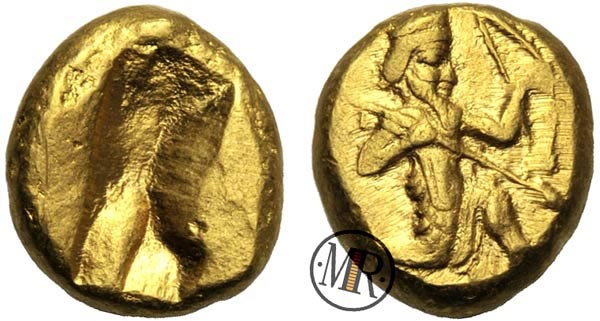
This gold coin was issued until the conquest of Persia by the Macedonians.
The largest ancient gold coin ever made in that period was minted in Ancient Greece by King Eucratide, of which we have also spoken in this article: Greek coin.
The gold coin that circulated in Ancient Rome was the aureus (aureus), issued in 49 BC by Julius Caesar, although already from 250 BC were minted gold coins called statere and half statere.
Julius Caesar established the weight of the gold in 1/40 of the Roman pound, about 8 grams (which is the weight of the modern English sovereign coin).
The gold was issued until the beginning of the 4th century AD when Constantine I, in 309 AD, introduced the solidus to replace the gold.
The solid coin, mostly found in the Eastern Empire, had a larger diameter and was thinner than the gold.
We must then arrive at the end of the seventh century when Umayyad Caliph Abd al-Malik ibn Marwān, following numerous reforms, introduced the minting of a gold coin for the Caliphate and this coin took the name Dīnār.
Initially it was minted imitating the coin of the Byzantine basileus Heraclius, later the caliph imposed the removal of the images and that the coin was totally epigraphic.
In the tenth century AD was introduced in Sicily by the Fatimids, Shiite dynasty Ismailite, an Arabic gold coin with a value of about ¼ of the Dīnār that later became known as Tarì.
Other types of Tarì were minted in Amalfi, even after the conquest by Frederick II, and was coined until 1282.
In the kingdom of Sicily it was then reintroduced by Ferdinand II of Aragon, but this time as a silver coin.
Barbarian gold coins
During the Middle Ages, some of the various so-called “barbarian” peoples who invaded the territories of the decayed Western Roman Empire, produced gold coins.
Longobards and Visigoths continued the minting of the types of gold coins present at the end of the Roman Empire.
Starting from the fifth century the Visigoths minted solid and tremissi in gold, initially imitating the circulating coins of the Eastern Roman Empire.
Later, in the 80s of the sixth century, the kings of the Visigoths from Leovigildo began to mint coins in their own name.
Here below is a tremisse by Leoviglido (567-586).
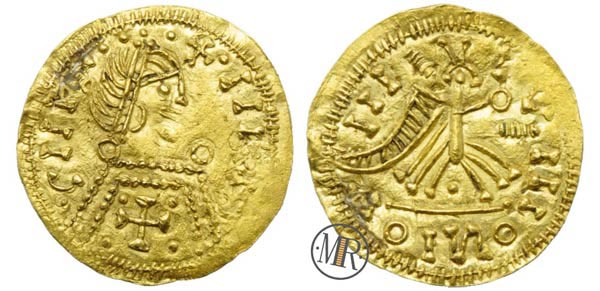
Even the Lombards began to emit mostly tremissi, initially in imitation of the Roman ones.
Then, with King Cuniperto, they began to mint gold coins in the name of the King.
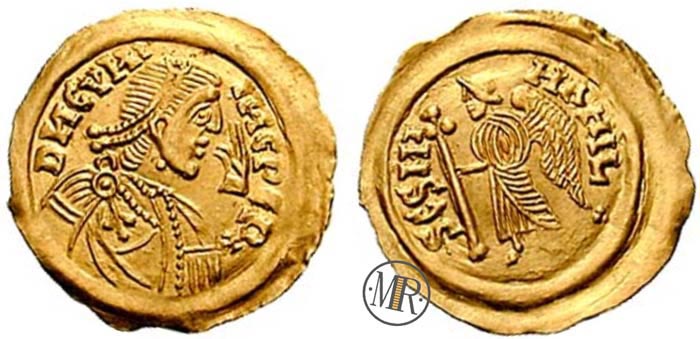
When Charlemagne came down to Italy conquering Pavia and assuming the title of king of the Franks and the Longobards, also the Franks began, even if for a short period (774-781), to mint tremissi coins in gold in the name of Charlemagne.
The known ticks of Charlemagne’s tremissi are Milan, Pavia, Bergamo, Chur, Lucca and Castelseprio.
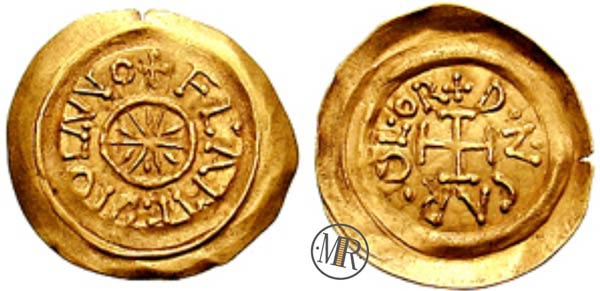
Italian Gold Coins: the Florin, Genovino and Zecchino
In 1252, as we have already seen in this article on the gold florin coin, in Florence began precisely the minting of the famous Fiorino d’oro, so called because of the large lily flower on the obverse of the coin.
In 1252 also Genoa began the minting of a gold coin: the Genovino.
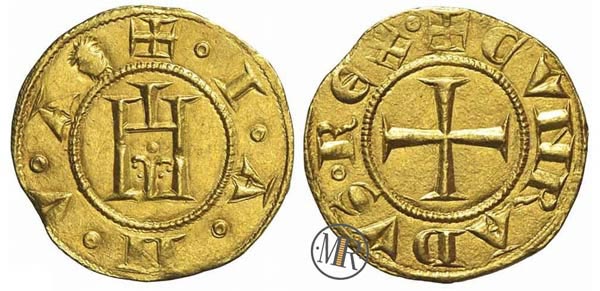
On the obverse of the Genoese gold coin appears the stylization of the door of a castle and the inscription + IANVA.
On the reverse side stands the heraldic cross with the inscription CVNRADVS REX, referring to Corrado III, King of the Romans, who in 1139 granted Genoa the right to mint coins.
The “Zecchino” Golden Coin
Also Venice, in 1284 under the government of the doge Giovanni Dandolo, began to beat a gold coin with the same weight and title as the Fiorino.
The name Zecchino derives directly from “Zecca” (mint), the structure responsible for the minting of coins.
On the obverse of this gold coin appear St. Mark, protector of the city, and the doge kneeling. St. Mark holds the gospel in one hand while with the other hand hands the doge the banner of the city.
The legend to the obverse shows “S M VENET” plus the name of the doge and DVX along the flagpole.
On the reverse instead the inscription is “SIT T XPE DAT Q TU REGIS ISTE DUCAT” that is “let it be entrusted to you, O Christ, this duchy that you govern” and represented Christ blessing, inserted inside a halo shaped like an almond.
The iconography remained practically unchanged until 1797. Here below is a gold coin of the last Doge of Venice, Lodovico Giovanni Manin.

Gold investment coins
Among the many gold coins circulated over the centuries, some are still investment gold coins today. We have talked a lot about this type of coins in our article about buying gold.
Now, the main ones we will talk about here are: Sovereign, Krugerrand, Marengo, 50 Mexican pesos, $20 and Chinese Golden Panda.
English Sovereign coins, known in Italy as the Golden Pound, is an English gold coin minted for the first time in 1489 and about which we have already spoken in this article: the Sovereign coin.
South African Krugerrand
Another investment gold coin is the South African Krugerrand, minted with the aim of supporting South African gold on the market in 1967.
The name of this gold coin comes from the portrait of Paul Kruger, known as Oom Paul ( Uncle Paul), famous leader of the Boer resistance against the British government of South Africa.

This gold coin contains a troy ounce of pure gold, has a diameter of 32.77 mm and a thickness of 2.84 mm. If you are looking for information about the ONCIA unit of measurement, which is important when it comes to gold coins.
This gold coin contains an ounce of pure gold, has a diameter of 32.77 mm and a thickness of 2.84 mm.
On the obverse, together with the portrait of Kruger, the inscription “SUID-AFRIKA/SOUTH AFRICA” in Afrikaans and English, on the reverse side there is a “springbok”, a gazelle typical of South Africa, and the face value of the coin.
If you have similar coins or some other piece you want to sell individually or in lots, you can rely on the partner we always use to buy or sell coins online: click here to open his site. (registration and item listing are free).
Italian Marengo and French Napoleon Coins
In another article we have already talked extensively about another gold investment coin that is the coin with the denominations of 20 Italian lira (marengo) and 20 French francs (napoleon coin).
Mexican Gold Coin
Mexico also minted in 1921, on the centenary of the beginning of the War of Independence against Spain, a gold coin worth 50 pesos. This is the largest existing investment coin and contains 37.50 grams of fine gold 900/1000.
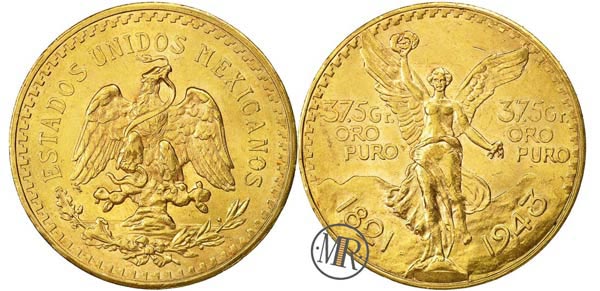
20 Dollars “Double Eagle”
The U.S. has instead issued, since 1849, a $20 gold coin known as the “Double Eagle”. It contains 30,0926 grams of gold up to 21.6 carats, which had a value of twenty dollars in 1849.
There are two types: a first type called Liberty Head, coined from 1849 to 1907, and a second type called Saint-Gaudens from 1907 onwards.
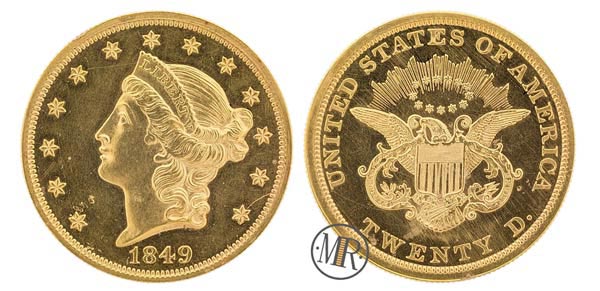
20 $ Liberty Head type

20$ Saint Gaudens

